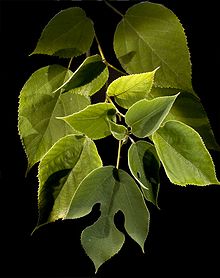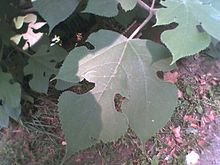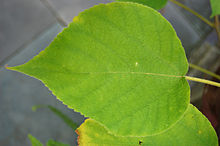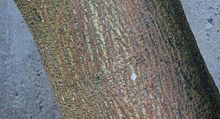- Paper Mulberry
-
Paper Mulberry 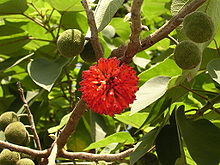
Paper Mulberry fruit, immature and mature Scientific classification Kingdom: Plantae (unranked): Angiosperms (unranked): Eudicots (unranked): Rosids Order: Rosales Family: Moraceae Tribe: Moreae Genus: Broussonetia Species: B. papyrifera Binomial name Broussonetia papyrifera
(L.) Vent.The Paper Mulberry (Broussonetia papyrifera, syn. Morus papyrifera L.) is a tree in the family Moraceae, native to eastern Asia. Other names include Dak, Halibun, Kalivon, Kozo, and Tapacloth tree.
It is a deciduous tree growing to 15 metres (49 ft) tall. The leaves are variable in shape (even on the same branch), unlobed ovate cordate to deeply lobed, with lobed leaves more frequent on fast-growing young plants; they are 7–20 centimetres (2.8–7.9 in) long, with a rough surface above, fuzzy-downy below and a finely serrated margin. The male (staminate) flowers are produced in an oblong inflorescence, and the female (pistillate) flowers in a globular inflorescence. In summer, the pistillate flower matures into a red to orange, sweet, juicy fruit 3–4 centimetres (1.2–1.6 in) diameter, which is an important food for wild animals. The fruit is edible and very sweet, but too fragile to be commercialised.
During the months of February until April proximity to this tree can contribute to severe pollen allergy. In Islamabad, Pakistan the pollen count goes as high as 40000 per m³ causing severe problems for residents.
Contents
Uses
The bark is composed of very strong fibres, and can be used for making high-quality paper. (See: Japanese tissue, Japanese paper and Hanji.) The tender leaves and twigs can be used to feed deer, and the tree is sometimes nicknamed the "Deer's Tree".
The paper mulberry tree was brought to the Pacific during the Polynesian migrations, and its bark is widely used to make tapa cloth.
Cultural reference
Represents the territory tree of the Islamabad Capital Territory (unofficial).
Invasive species
The fast growing Paper Mulberry when introduced to non-native areas can quickly disrupt the native habitat, becoming a highly invasive species and upsetting the natural ecosystem. This has proven true in many places, including parts of Latin America, the United States, and South Asia, and is particularly conspicuous in the vicinity of the city of Islamabad, where Paper Mulberry was introduced for its scenic value but is now replacing the native flora at an alarming rate. The pollen from this tree is the number-one cause of allergy problems in Islamabad.[citation needed]
Paper Mulberry chokes out native flora because of its very high consumption of water, which leaves less water to sustain the native flora. Because its root system, while extensive, is shallow, it is also prone to being blown down by high winds. When cut, the trees release a latex-heavy sap which is extremely sticky and can ruin clothing. After cutting, the tree needs to be killed by applying herbicide to the stump, or the root system will send out multiple coppices which grow quickly from the existing root system. The roots of the tree are aggressive enough to break cinder blocks and cause problems to drainage pipes. The timber is relatively useless, and the strong fibers which make the pulp valuable simply dull saw blades in residential removal.[citation needed]
External links
- Broussonetia papyrifera
- Broussonetia papyrifera (in Spanish)
Categories:- Moraceae
- Invasive plant species
- Flora of Asia
- Naturalized trees of Hawaii
Wikimedia Foundation. 2010.

